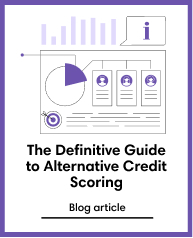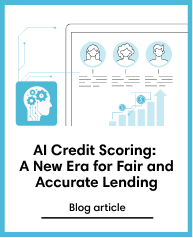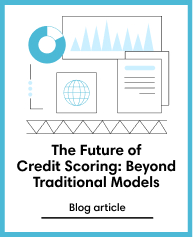Credit Scoring
Jul 23, 2021
Credit Scoring in the United States of America
Subscribe to our newsletter
A 2021 study revealed that financial inclusion in the US has significantly improved over the past few years, with financial technology or fintech businesses and smaller financial institutions playing a key role in reaching unbanked Americans. In addition, modern financial solutions have significantly enhanced the way lending, in particular, is done, helping millions of Americans fulfil their investment goals and finally become financially included.
Up until 1956, credit bureaus in the US measured the creditworthiness of borrowers based on payment history, word-of-mouth, and home visits. However, these methods proved to be ineffective due to the lack of accurate quantitative data. In some cases, lenders would even judge borrowers based solely on their character. Engineer Bill Fair and mathematician Earl Isaac later changed the game by creating the country’s first credit scoring system, which was later refined into the FICO Score introduced in 1989.
Today, most banks and creditors in the US use the FICO model to measure the creditworthiness of borrowers. Moreover, this impartial credit scoring system helps Americans get fair access to credit when they need it, increasing the number of financially included people in the country.
What is a FICO Score?
A FICO Score is a three-digit number calculated from data from borrowers’ credit reports at three of the US’ major consumer reporting agencies: Experian, TransUnion, and Equifax. The overall FICO Score range is between 300 and 850. Borrowers with a score of 670 or higher are considered highly dependable in paying their debts on time, while those who fall under the 580 to 669 score range may be less dependable but will have the chance to have their credit or loan applications approved. Conversely, borrowers with a score of 580 and below are considered risky. According to FICO, about 190 million Americans have FICO Scores.
The one downside to credit scores is in order to have one, you need to have a credit history. But to build a credit history, you also need a credit score. Unfortunately, this predicament leaves millions of Americans with little to no access to credit opportunities, excluding them from financial stability and comfortable lives.
According to the Consumer Financial Protection Bureau, one in 10 adults, or approximately 26 million Americans, as of 2021 mainly complete transactions using cash or debit cards, making them credit invisible. Meaning, they have little to no credit history with any of the three major credit bureaus and have no way of proving their creditworthiness. Without a credit history, they are unable to build their credit score and access financial products.
As if building credit history and credit score are not hard enough, 2020 became especially turbulent for many borrowers. Because of the economic effects of the COVID-19 pandemic, 21% of Americans were denied credit due to their low credit scores. Millennials were the hardest hit by the credit climate during the pandemic, with 32% of them having their credit applications denied. Meanwhile, only 22% of Gen Xs and 11% of Baby Boomers experienced rejection.
How alternative data comes into play
In consideration of the challenges that Americans face when it comes to credit or loan access, many financial institutions today have been using alternative data not found in traditional consumer credit reports. Some alternative data sources include utilities, telecom, rent, property or asset records, public records, alternative lending payments, and demand deposit account (DDA) information―data most Americans already have and can present as proof of their ability to pay financial obligations on time.
In this digital age, financial companies have developed alternative credit scoring solutions using other data sources such as airtime usage, mobile money usage, geolocation, bills payment history, and social media usage.
In 2016, FICO took advantage of this new credit scoring method by launching FICO Score XD, a system that looks at public records and a person’s history with phone, cable, and utility payments to generate scores on the same 300-850 scale used for standard FICO Scores. Using alternative data, FICO Score XD complements the standards of traditional credit bureaus. The system now helps new credit applicants easily get a FICO Score. Consumers with retired credit can update their financial activity in real-time. Consumers with lost access to credit receive credit for positive payment patterns such as paying bills on time, and applicants with no credit bureau record can finally access mainstream banking.
How credolab complements FICO Score XD
As a leading alternative credit scoring platform, we offer a fully digital embedded scoring solution that uses non-intrusive smartphone usage behaviour metadata to arrive at the credit score. No private nor sensitive information of the applicant is accessed or moved out of the mobile phone. As stated in our privacy policy, the data we collect include SMS message history, contacts, calendars, list and storage of applications on mobile phones and device hardware type, operating system, language, keystroke patterns and similar information on web devices.
Our solutions are designed to improve and streamline traditional credit scoring methods, helping lenders gain more qualified applicants and improve their business operations.
The low correlation of credolab’s data source to those used by FICO Score XD amplifies the overall predictiveness of any scoring algorithm. It uplifts the accessibility to the credit of an entire population and not just new-to-credit customers by adding a new and more holistic dimension to the underwriting process.
Therefore combining them with those used by FICO Score XD can help lenders better assess credit or loan applicants. The more sources of alternative data are used, the more previously unscorable individuals can access credit opportunities. Additionally, more alternative data can give credit lenders stronger credit predictions, thus giving worthy but overlooked credit applicants financial support for their needs and investments.
With these alternative data solutions in the market today, credit risk management and loan lending are now more convenient than ever, opening up the finance space to more people. As a result, financial inclusion in the US will continue improving over the next few years with the providing of more credit or loan opportunities to previously unscorable individuals.





